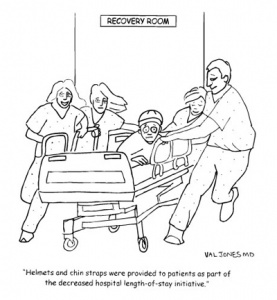December 7th, 2008 by Dr. Val Jones in Audio, Expert Interviews
No Comments »
 |
|
Nancy Schlichting
|
“Detroit is the poorest city in America. But we’re not going to be victims of circumstance. We’re going to rise up and lead the country in healthcare quality and become part of the economic solution for our community. The Henry Ford hospital name must mean something when people drive up to it.”
– Nancy Schlichting, President and CEO, The Henry Ford Health System, Detroit, Michigan
I sheepishly admit to being surprised that a hospital system in Detroit was singled out for a national award for hospital quality and safety. Who would think that the poorest city in America could be a beacon of light in these dark times in healthcare? The story of Henry Ford Health System, and its female president and CEO, Nancy Schlichting, is both inspirational and motivational. I had the chance to interview Nancy at a recent award ceremony at the National Press Club where she received the 2008 National Health System Patient Safety Leadership Award.
You may enjoy our conversation via podcast, but please forgive the “tinny” sound quality. I recorded our conversation with a little hand-held digital device instead of my usual recorded phone line.
[Audio:http://blog.getbetterhealth.com/wp-content/uploads/2008/12/nancyschlichting.mp3]
Dr. Val: Congratulations on winning the National Health System Patient Safety Leadership Award. Has improving patient safety at your hospital been a challenge?
Schlichting: On a given day, a patient may encounter up to 50 different hospital employees. Coordinating our efforts so that the patient’s experience is consistently positive and error-free is certainly challenging.
We have 7 pillars of performance at Henry Ford, and the first is “people.” We like to say that we “have to take care of the people who are taking care of people.” We need to make sure that they have the resources they need, that the processes are in place so they can do their jobs well, and that they get their individual needs met. For example, everyone knows my email address and they can contact me at any time if they’re not getting their problems resolved. I respond to every single email. This creates a culture of openness and responsibility. They know that the person at the top cares about them.
Dr. Val: A prominent community member experienced an unfortunate lapse in communication during his hospital stay, which resulted in compromise of his care, and he eventually died in the hospital. You personally met with his wife and promised her that you’d take the necessary steps to ensure that this never happened again. Tell me more about that.
Read more »
December 6th, 2008 by Dr. Val Jones in Humor
3 Comments »
You know those people who still have their Christmas lights up in April? Yeah, that’s always annoyed me… But I’m afraid that I’ve recently been reminded of the old Muslim proverb: “Don’t point fingers because three will be pointing back at you.”
My exasperation level has reached a creschendo and I think I’m going to have to take matters into my own hands. My husband has been keeping rotting organic material on our balcony, and it is a source of growing embarrassment.

Exhibit A
Exhibit A: Rosemary bush from Christmas ’07. This little bush was purchased by my husband in an effort to bring the “holiday spirit” to our household last year. I had previously argued that killing trees was not part of the true meaning of Christmas and that I didn’t relish the idea of sweeping up pine needles for months. Besides, we don’t have kids, so why get a tree at all? So he got me a rosemary bush and decorated it with items from my jewelry box. It was amusing at the time. But the bush is still alive (albeit barely) and on our balcony in time for Christmas ’08.

Exhibit B
Exhibit B: A pumpkin that was carved by my husband in late October, 2008. He found the vegetable at our local farmer’s market and asked me to participate in creating a Jack-O-Lantern. He insisted that my “considerable artistic talent” could be applied to the pumpkin with great effect. I responded that since our balcony faces a series of rooftop fume hoods, I doubted that the proud display of such an effort would be appreciated by more than the local rodent population. So hubby carved the pumpkin himself (using a simple stencil) and placed his work directly in front of my office window. It made me chuckle, but little did I know that he planned to allow the pumpkin to “degrade naturally to fertilize the bamboo” after it had served its holiday purpose.
I suppose that these two balcony dwellers serve as a reminder of my own “Grinchly” ways. Nonetheless, I’m coming to the end of my rope and am poised with garbage bag in hand to start the 2008 holidays with a clean slate. Would you agree that it’s time to remove the exhibits? With whom do you relate more: the organic-matter-hording husband, or the curmudgeonly wife?
December 5th, 2008 by Dr. Val Jones in Opinion
3 Comments »
Thanks to KevinMD for pointing out a recent NYT article about “etiquette-based medicine.” The author, a psychiatrist, suggests that physicians should use a check list to ensure courteous behavior and that this sort of thing should be taught in medical school. His suggestions were also published in the New England Journal of Medicine:
• Ask permission to enter the room; wait for an answer.
• Introduce yourself; show your ID badge.
• Shake hands.
• Sit down. Smile if appropriate.
• Explain your role on the health care team.
• Ask how the patient feels about being in the hospital.
If this sort of thing isn’t intuitively obvious to a physician then I’d say the blame should rest with his parents not his medical school. I mean, do we really need to teach doctors to knock on doors and smile on cue? Aren’t those sorts of things taught in pre-school?
It grieves me that some of my peers do not display what some might call “normal behavior” when interacting with patients. But I don’t think that’s related to their medical school curriculae – it’s the sad result of a broken healthcare system that wears thin our common human decency. Doctors are exhausted by clinical volume, henpecked by bureaucracy, delirious from lack of sleep, and stressed out by the daily grind of bad news, disease progression, and death. When well-groomed adults of sound mind require a checklist in order to smile appropriately, you know something’s terribly wrong.
Now, I don’t excuse disrespectful behavior – we docs must rise above our natural urge to be irritable at times, and remember that our patients are vulnerable and need our help. But for heaven’s sake… let’s drop the smug check lists and finger pointing. We’re all in this together, and it ain’t pretty.
December 4th, 2008 by Dr. Val Jones in Quackery Exposed
No Comments »
This post is a follow up to my book review of Bad Science, located here.
***
I couldn’t help but feel unusually depressed by Dr. Ben Goldacre’s exposé of researchers who resort to trickery to get their articles published in peer-reviewed journals. There are a number of ways to manipulate data and many ways that flawed research is presented to enhance its chances of publication.
Before we get started, I need to point out that “negative trials” – or research results that don’t corroborate the investigator’s original hypothesis/es – are much less likely to be published. People (and/or publishers) are far more interested in finding a needle in a haystack, than hearing that no needle could be found. This is a driving force in all manner of mathematical convolutions aimed at demonstrating something interesting and to warrant publication. After all, who can blame the researchers for wanting to get their research published, and to have it make a meaningful contribution to their field of study? Who wants to toil for months to years on end, only to discover that their hypotheses were not born out by experimentation, and in fact no helpful conclusions may be drawn whatsoever?
And so, with this intense pressure to find something meaningful in one’s research (either for profit or personal satisfaction and professional advancement) – there are some typical stragegies that researchers use to make something out of nothing. Ben Goldacre reviews these strategies in the voice of an unscrupulous senior pharmaceutical investigator, giving advice to his junior colleague. (Parenthetically, it reminded me of The Screwtape Letters – an amusing book written by C.S. Lewis, featuring the imaginary advice of a senior demon to his junior counterpart as they tempt humans to evil.)
(This passage is taken directly from pages 192-193 of Bad Science)
1. Ignore the protocol entirely. Always assume that any correlation proves causation. Throw all your data into a spreadsheet programme and report – as significant – any relationship between anything and everything if it helps your case. If you measure enough, some things are bound to be positive by sheer luck.
2. Play with the baseline. Sometimes, when you start a trial, quite by chance the treatment group is already doing better than the placebo group. If so, then leave it like that. If, on the other hand, the placebo group is already doing better than the treatment group at the start, then adjust for the baseline in your analysis.
3. Ignore dropouts. People who drop out of trials are statistically much more likely to have done badly, and much more likely to have had side effects. They will only make your drug look bad. So ignore them, make no attempt to chase them up, do not include them in your final analysis.
4. Clean up the data. Look at your graphs. There will be some anomalous ‘outliers,’ or points which lie a long way from the others. If they are making your drug look bad, just delete them. But if they are helping your drug look good, even if they seem to be spurious results, leave them in.
5. The best of five… no… seven… no… nine! If the difference between your drug and placebo becomes significant four and a half months into a six-month trial, stop the trial immediately and start writing up the results: things might get less impressive if you carry on. Alternatively, if at six months the results are ‘nearly significant,’ extend the trial by another three months.
6. Torture the data. If your results are bad, ask the computer to go back and see if any particular subgroups behaved differently. You might find that your drug works very well in Chinese women aged fifty-two to sixty-one. ‘Torture the data and it will conhfess to anything’ as they say at Guantanamo Bay.
7. Try every button on the computer. If you’re really desperate, and analysing your data the way you planned doesn’t give you the results you wanted, just run the figures through a wide selection of other statistical tests, even if they are entirely inappropriate, at random.
8. Publish wisely. If you have a good trial, publish it in the biggest journal you can possibly manage. If you have a positive trial, but it was a completely unfair test, then put it in an obscure journal… and hope that readers are not attentive enough to read beyond the abstract to recognize its flaws.
9. Do not publish. If your finding is really embarrassing, hide it away somewhere and cite ‘data on file.’ Nobody will know the methods, and it will only be noticed if someone comes pestering you for the data to do a systematic review. Hopefully that won’t be for ages.














